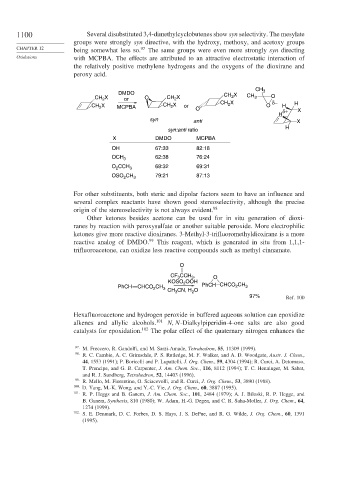Page 1124 - Advanced Organic Chemistry Part B - Reactions & Synthesis
P. 1124
1100 Several disubstituted 3,4-dimethylcyclobutenes show syn selectivity. The mesylate
groups were strongly syn directive, with the hydroxy, methoxy, and acetoxy groups
CHAPTER 12 being somewhat less so. 97 The same groups were even more strongly syn directing
Oxidations with MCPBA. The effects are attributed to an attractive electrostatic interaction of
the relatively positive methylene hydrogens and the oxygens of the dioxirane and
peroxy acid.
CH 3
DMDO CH X
X O X 2 CH 3 O
CH 2 or CH 2
2
CH X MCPBA CH X or O CH X O δ− H H
2
2
H δ+ X
syn anti X
H
syn:anti ratio
X DMDO MCPBA
OH 67:33 82:18
OCH 3 62:38 76:24
O CCH 3 68:32 69:31
2
OSO CH 3 79:21 87:13
2
For other substituents, both steric and dipolar factors seem to have an influence and
several complex reactants have shown good stereoselectivity, although the precise
origin of the stereoselectivity is not always evident. 98
Other ketones besides acetone can be used for in situ generation of dioxi-
ranes by reaction with peroxysulfate or another suitable peroxide. More electrophilic
ketones give more reactive dioxiranes. 3-Methyl-3-trifluoromethyldioxirane is a more
reactive analog of DMDO. 99 This reagent, which is generated in situ from 1,1,1-
trifluoroacetone, can oxidize less reactive compounds such as methyl cinnamate.
O
CF CCH , O
3
3
KOSO OOH
2
PhCH CHCO CH 3 PhCH CHCO CH 3
2
2
2
CH 3 CN, H O
97% Ref. 100
Hexafluoroacetone and hydrogen peroxide in buffered aqueous solution can epoxidize
alkenes and allylic alcohols. 101 N N-Dialkylpiperidin-4-one salts are also good
catalysts for epoxidation. 102 The polar effect of the quaternary nitrogen enhances the
97 M. Freccero, R. Gandolfi, and M. Sarzi-Amade, Tetrahedron, 55, 11309 (1999).
98
R. C. Cambie, A. C. Grimsdale, P. S. Rutledge, M. F. Walker, and A. D. Woodgate, Austr. J. Chem.,
44, 1553 (1991); P. Boricelli and P. Lupattelli, J. Org. Chem., 59, 4304 (1994); R. Curci, A. Detomaso,
T. Prencipe, and G. B. Carpenter, J. Am. Chem. Soc., 116, 8112 (1994); T. C. Henninger, M. Sabat,
and R. J. Sundberg, Tetrahedron, 52, 14403 (1996).
99 R. Mello, M. Fiorentino, O. Sciacevolli, and R. Curci, J. Org. Chem., 53, 3890 (1988).
100
D. Yang, M.-K. Wong, and Y.-C. Yie, J. Org. Chem., 60, 3887 (1995).
101 R. P. Heggs and B. Ganem, J. Am. Chem. Soc., 101, 2484 (1979); A. J. Biloski, R. P. Hegge, and
B. Ganem, Synthesis, 810 (1980); W. Adam, H.-G. Degen, and C. R. Saha-Moller, J. Org. Chem., 64,
1274 (1999).
102
S. E. Denmark, D. C. Forbes, D. S. Hays, J. S. DePue, and R. G. Wilde, J. Org. Chem., 60, 1391
(1995).

